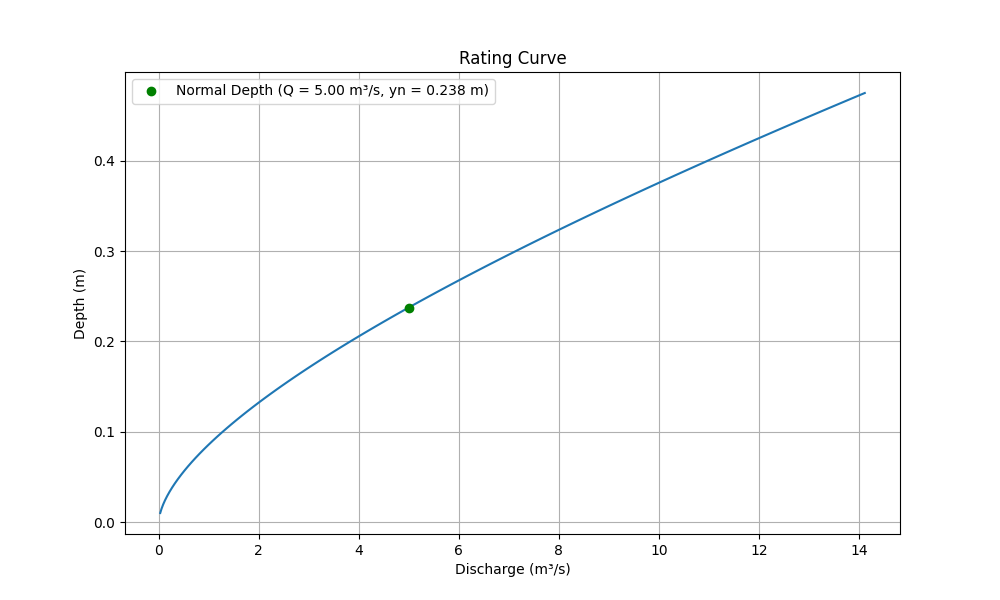It was the late 1990s when I hunched over my keyboard, meticulously typing line after line of code for my Open Channel Hydraulics class. The assignment seemed monumental at the time—create programs that could calculate critical depth, normal depth, and other flow characteristics for various channel cross-sections. Those programs earned me excellent grades and a deeper understanding of hydraulic principles that would serve me throughout my career.
Fast forward 25 years, and I find myself in a conversation with Claude 3.7 Sonnet, one of the latest large language models from Anthropic. Out of curiosity, I asked it to write Python code for calculating critical depth in open channels with various cross-sections. What happened next was both fascinating and humbling.
Then: The Hard-Earned Skills of Engineering Programming
Back in my university days, creating hydraulic calculation programs required:
- Deep understanding of the underlying hydraulics principles
- Proficiency in programming languages like FORTRAN or early C++
- Hours of debugging strange edge cases
- Careful documentation of every variable and function
- Weeks of work to get everything functioning correctly
Those programs were simple by today's standards—command-line interfaces with minimal error handling and no visualizations. But they worked, and creating them taught me as much about programming discipline as they did about hydraulic engineering.
We'd spend hours in the computer lab, running test cases, comparing results with hand calculations, and fine-tuning our code. The programs were our digital proof that we understood concepts like:
- Critical depth where specific energy is minimized
- Manning's equation for normal depth
- The relationship between channel geometry and flow characteristics
- Numerical methods for solving hydraulic equations
Now: AI-Generated Hydraulic Engineering Code
When Claude provided its solution to my request, I was genuinely stunned. In seconds, it delivered comprehensive Python code that:
- Implemented object-oriented design with a base class and derived classes for different channel shapes
- Handled rectangular, trapezoidal, triangular, circular, and parabolic cross-sections
- Calculated critical depth using numerical optimization
- Included an analytical solution for rectangular channels
- Generated specific energy diagrams with matplotlib
When I asked it to add functionality for normal depth and discharge calculations, it immediately enhanced the program with:
- Manning's equation implementation for normal depth
- Discharge calculations for any given depth
- Rating curve visualization
- Froude number calculations and flow regime classification
- A user-friendly interface with multiple calculation modes
The entire exchange took less than five minutes of my time, resulting in a program that would have taken me days or weeks to write 25 years ago.

What This Means for Engineering Education and Practice
This experience has me reflecting on how we teach and practice hydraulic engineering today:
The Shifting Value Proposition
The value no longer lies in the ability to write code from scratch—AI can now handle that with impressive accuracy. Instead, the value shifts to:
- Understanding the theoretical principles deeply enough to know what to ask for
- Verifying and validating AI-generated solutions
- Interpreting results in context and making engineering judgments
- Identifying edge cases where standard approaches might fail
The New Engineering Workflow
Today's hydraulic engineers might approach problems with a workflow that looks like:
- Formulate the problem precisely
- Ask an AI to generate a solution approach or code
- Review, modify, and extend the solution as needed
- Apply engineering judgment to interpret and implement the results
What Still Matters
Despite these dramatic changes, some aspects of engineering education remain crucial:
- Fundamental understanding of hydraulic principles
- Critical thinking about results and limitations
- Physical intuition about how water behaves in channels
- Professional responsibility for engineering decisions
Looking Forward
As I reflect on this experience, I'm not sad that something that once took me weeks now takes AI seconds. Instead, I'm excited about what this means for the future of hydraulic engineering:
- More accessible tools for engineers in resource-constrained environments
- Faster iterations on design problems
- More time for engineers to focus on creative solutions and critical thinking
- Easier exploration of multiple design alternatives
The core of hydraulic engineering isn't coding—it's understanding how water moves and how we can safely and efficiently manage it. If AI can handle the programming heavy lifting, it frees us to focus on the aspects of engineering that require human judgment, creativity, and responsibility.
My old programs earned me good grades 25 years ago. But today's AI-assisted approaches might just help us build better water infrastructure for the next 25 years and beyond.
What's Next?
I'm curious to hear from other engineers: How has AI changed your workflow? Are you using tools like Claude to accelerate routine tasks? And most importantly, how are we adapting engineering education to prepare students for this new reality?
Share your thoughts and experiences in the comments below.